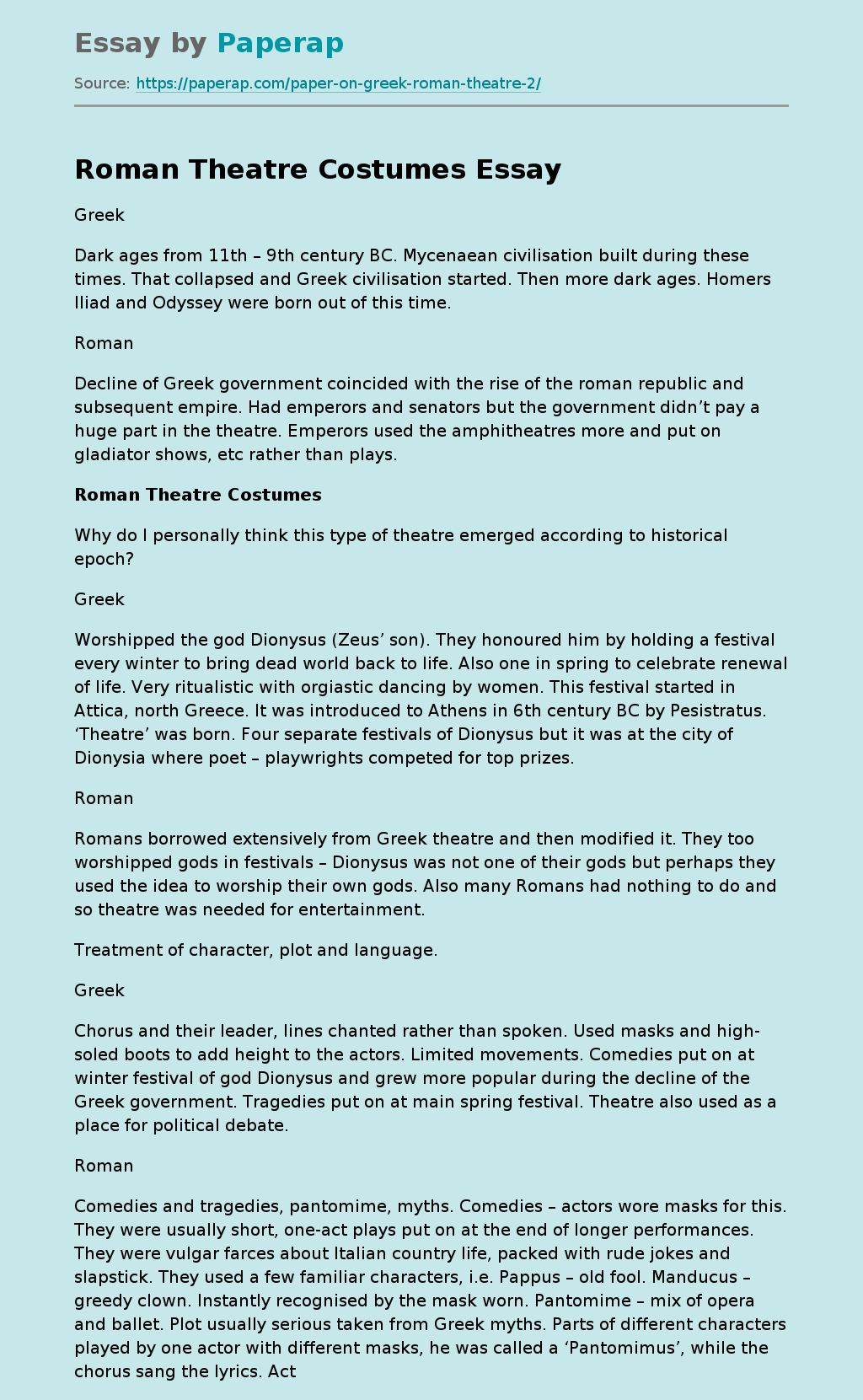Roman Theatre Costumes
Greek
Dark ages from 11th – 9th century BC. Mycenaean civilisation built during these times. That collapsed and Greek civilisation started. Then more dark ages. Homers Iliad and Odyssey were born out of this time.
Roman
Decline of Greek government coincided with the rise of the roman republic and subsequent empire. Had emperors and senators but the government didn’t pay a huge part in the theatre. Emperors used the amphitheatres more and put on gladiator shows, etc rather than plays.
Roman Theatre Costumes
Why do I personally think this type of theatre emerged according to historical epoch?
Greek
Worshipped the god Dionysus (Zeus’ son).
They honoured him by holding a festival every winter to bring dead world back to life. Also one in spring to celebrate renewal of life. Very ritualistic with orgiastic dancing by women. This festival started in Attica, north Greece. It was introduced to Athens in 6th century BC by Pesistratus. ‘Theatre’ was born. Four separate festivals of Dionysus but it was at the city of Dionysia where poet – playwrights competed for top prizes.
Roman
Romans borrowed extensively from Greek theatre and then modified it. They too worshipped gods in festivals – Dionysus was not one of their gods but perhaps they used the idea to worship their own gods. Also many Romans had nothing to do and so theatre was needed for entertainment.
Treatment of character, plot and language.
Greek
Chorus and their leader, lines chanted rather than spoken. Used masks and high-soled boots to add height to the actors.
Limited movements. Comedies put on at winter festival of god Dionysus and grew more popular during the decline of the Greek government. Tragedies put on at main spring festival. Theatre also used as a place for political debate.
Roman
Comedies and tragedies, pantomime, myths. Comedies – actors wore masks for this. They were usually short, one-act plays put on at the end of longer performances. They were vulgar farces about Italian country life, packed with rude jokes and slapstick. They used a few familiar characters, i.e. Pappus – old fool. Manducus – greedy clown. Instantly recognised by the mask worn. Pantomime – mix of opera and ballet. Plot usually serious taken from Greek myths. Parts of different characters played by one actor with different masks, he was called a ‘Pantomimus’, while the chorus sang the lyrics. Actors were usually Greek slaves or freedmen.
Costume and staging.
Greek
Tragic costume – tight-sleeved, belted tunic (chitin) a variety of cloaks over tunic and boots. Helmet-like mask with attached wig in which forehead was elevated as a sign of social status. Greek theatres had a circular orchestra. It was built into a hill, not free standing. Also had rooms behind orchestra called the Skene – had doors from which actors could go off and come on stage from. Murders usually took place ‘behind closed doors’. Tiered seating. A few set pieces of scenery i.e. rocks and tombs. Scenes sometimes painted onto the Skene.
Roman
Wore masks to show off different characters. Masks made of linen covered wit plaster and painted. Theatre itself – semi-circular stage called the orchestra, tiered seating. Series of rooms behind orchestra – storage of scenery and props. Actors dressing rooms as well. It was a freestanding building (see pic)
Both made use of special effects and machines. Such as a wagon (eccylema) on which bloody tableaux were displayed and a crane on which actors playing gods could be flown in. E.g. in roman theatre, the Greek myth of Daedalus and Icarus was put on in theatre. A slave would be suspended above the orchestra by crane, dropped and killed to show Icarus’ wings falling apart and him falling into the sea.
Conventions that emerged.
Roman and Greek
Since roman theatre was descended from Greek, conventions are very similar. Both have a chorus, which played music to go with the play.
Greek
Usually more than one actor all with slightly varied costumes
Roman
Especially in pantomime – one actor that changed masks for different characters. Usually only a couple of actors in different masks in comedies and tragedies.
What was theatre’s social and political function at the time?
Greek
Entertainment. To inform about history. Put on at festivals.
Roman
Put on at festivals for entertainment. It was a public occasion and was free. All expenses paid for by a wealthy citizen who provided everything i.e. actors, producer, scenery and costumes. Volunteered to do it not only to benefit fellow citizens but also to gain popularity, which would be useful in local political elections.
Roman Theatre Costumes. (2019, Dec 05). Retrieved from https://paperap.com/paper-on-greek-roman-theatre-2/

